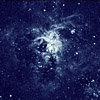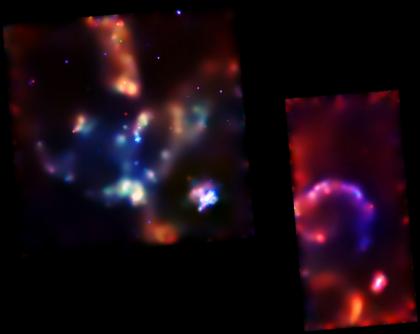A Drama of Star Formation and Evolution
The Chandra image of the Tarantula Nebula gives scientists a close-up view of the drama of star formation and evolution. The Tarantula, also known as 30 Doradus, is in one of the most active star-forming regions in our Local Group of galaxies. Massive stars are producing intense radiation and searing winds of multimillion-degree gas that carve out gigantic super-bubbles in the surrounding gas. Other massive stars have raced through their evolution and exploded catastrophically as supernovas, leaving behind pulsars and expanding remnants that trigger the collapse of giant clouds of dust and gas to form new generations of stars.
30 Doradus is located about 160,000 light years from Earth in the Large Magellanic Cloud, a satellite galaxy of our Milky Way Galaxy. It allows astronomers to study the details of starbursts - episodes of extremely prolific star formation that play an important role in the evolution of galaxies.
At least 11 extremely massive stars with ages of about 2 million years are detected in the bright star cluster in the center of the primary image (left panel). This crowded region contains many more stars whose X-ray emission is unresolved. The brightest source in this region known as Melnick 34, a 130 solar-mass star located slightly to the lower left of center. On the lower right of this panel is the supernova remnant N157B, with its central pulsar.
Two off-axis ACIS-S chips (right panel) were used to expand the field of view. They show SNR N157C, possibly a large shell-like supernova remnant or a wind-blown bubble created by OB stars. Supernova 1987A is also visible just above and to the right of the Honeycomb Nebula at the bottom center.
In the image, lower energy X-rays appear red, medium energy green and high-energy are blue.
|
||||||||||||||||||||||||||||
The X-ray image of the supernova remnant Tarantula Nebula (30 Doradus) showcases a vibrant and intricate cosmic landscape divided into two observations or sections: a larger one on the left, and a smaller slim one on the right. In the image, there is a large, bright, and irregularly shaped object that resembles a swirling vortex. Surrounding this central feature, there are several smaller, circular objects that appear to be floating around the nebula, all on a black background. The overall color scheme of the image is dominated by shades of purple, pink, and blue, with occasional flashes of white and yellow. In the image, the colors are created from the lower energy X-rays appearing red, medium energy green and high-energy blue. At least 11 extremely massive stars with ages of about 2 million years are detected in the bright star cluster in the center of the primary image (left section). This crowded region contains many more stars whose X-ray emission is unresolved. The brightest source in this region is known as Melnick 34, a 130 solar-mass star located slightly to the lower left of center. On the lower right of this panel is the supernova remnant N157B, with its central pulsar. Two off-axis ACIS-S chips (right panel) were used to expand the field of view. They show SNR N157C, possibly a large shell-like supernova remnant or a wind-blown bubble created by OB stars. Supernova 1987a is also visible just above and to the right of the nebula at the bottom center.





